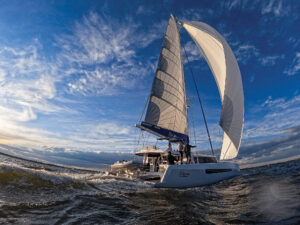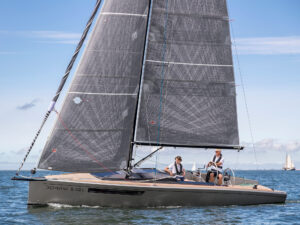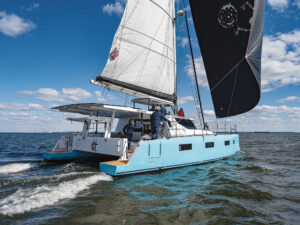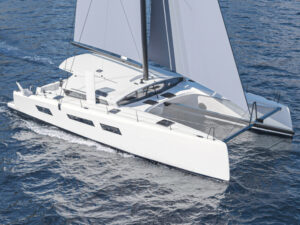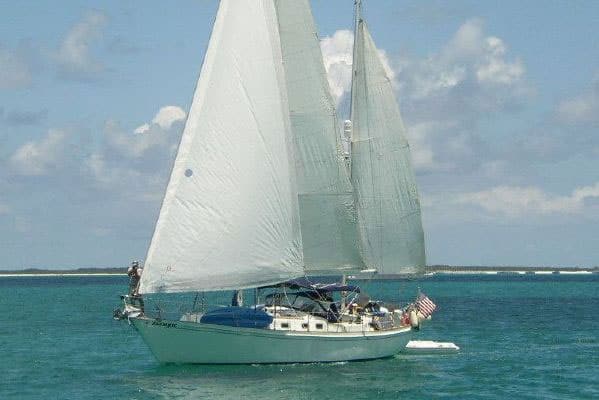
best-sailboat-whitby-42.jpg
A husky, voluminous 42-footer that nicely addressed the sometimes conflicting requirements of long-distance voyaging and long-term living aboard, the ketch-rigged Whitby 42 has been a fixture in far-flung anchorages since it was first launched in 1942. Originally built in Canada with a long, fixed keel, in later years a centerboard version was introduced and named the Brewer 12.8. Read a review of the Whitby 42. Courtesy of East Coast Yacht Sales
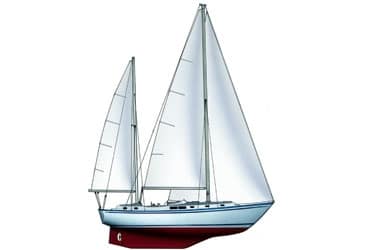
Whitby 42 368
Ted Brewer designed the Whitby 42 in 1971 for Whitby Boat Works in Canada. She has a 13-foot beam, 32-foot 8-inch waterline, and a moderate 5-foot draft. High freeboard allows a commodious interior, which in one of the two available cabin layouts boasts two swiveling armchairs, a spacious engine room, and a very comfortable aft cabin. Ample water tankage of 290 gallons provides for showers in two heads, and a 210-gallon fuel capacity assures good range under power. A cavernous refrigerator/freezer keeps perishables during an extended cruise, a locker for wet oilskins abuts the main companionway ladder, and a handy workbench sits in the passage aft by the engine room.
Some specifications listed a Volvo MD30A engine, but most Whitby 42s had a Ford Lehman 254 or Perkins 4-236, typically turning a propeller between 16 and 18 inches in diameter. This combination gives plenty of power for motorsailing, although with a generous sail area of 875 square feet, a long waterline, and well-
designed underbody, these ketches sail remarkably well – several owners report speeds of 7.5 to 8 knots on a close reach. In the 1970s, the Whitby 42 Revelation collected a number of firsts while racing under PHRF in California.
Comfortable, seaworthy, and forgiving of a novice sailor, the Whitby 42 found a receptive clientele, and Whitby Boat Works sold 233 of them before ceasing production in 1987. In 1979, Fort Myers Yacht and Ship Building in Florida obtained a license to the design and built 32 boats of reportedly high quality. Fort Myers changed the design in 1983 to a 4-foot draft with centerboard and named it the Brewer 12.8. In 1987, it was again modified into the Brewer 44, which was produced until 1991.
Joe Cordoba has owned and cruised Eugenia, his Whitby 42 (hull number two) for seven years. In 1993, on a passage from Isla Mujeres Mexico, to Fort Lauderdale, Florida, Joe – an experienced sailor with a green crew – ran into the “Storm of the Century.” His engine quit; he continued to tack northward under reduced sail. After the reefed main blew out, Eugenia sailed on under storm jib and reefed mizzen, eventually making Key West. Joe’s improvements reflect his experience. He fitted a sturdy gooseneck on the mainmast to take a mainsail roller-furling system and can now reduce the mainsail and mizzen areas more than the old slab reefs allowed. Nevertheless, he retained the trysail track for good measure. Crew can clip their harnesses onto jackstays running along the side decks and across the stern. The mizzen sheets are now mounted farther inboard from the stern to avoid obstructing access to the dinghy and boarding ladder. Joe recently installed a robust stern arch combined with davits to hoist the dinghy high enough to clear the sea when the boat rolls or the bow climbs over a wave. The arch will also support antennas and three large solar panels. A permanent bimini roof rests on aluminum tubing, which also carries removable clear vinyl panels to enclose the cockpit. To provide more space for cruising paraphernalia, he located the forward tubes of the enclosure support and a new coaming a couple of feet forward of the original companionway coaming.
Monotonous hours at the wheel in the foaming Gulf Of Mexico revealed the importance of the mizzen as an aid to steering and tacking the boat in rough conditions. Eugenia’s mizzen withstood the storm, firmly supported by a triatic stay and runners, but three Whitby 42s that we’ve heard of have lost mizzen masts overboard. According to reports, in these earlier boats the bulkhead under the mizzen, which is stepped on the aft cabin roof, flexes enough in a seaway for the mast to jump out of its step. A taller, more substantial mizzen heel-fitting with a pin through the mast, additional rigging, and stiffening the floor support under the aft bulkhead should stabilize the mast.
Joe suspected during the storm that the rudder might need enlarging. At the next haulout he added 8 inches of laminate to the trailing edge. Steering improved dramatically.
I recently learned about two incidents of rudder stocks breaking after the recommended addition to the rudder area. The bronze rudder stocks sheared at the upper section where the stock enters the hull. Whitby 42 owners planning extended ocean cruises should examine the rudders and possibly replace the old rudder stocks with new ones fabricated from Aquamet 22, a highly corrosion-resistant propeller shaft stainless-steel alloy.
Eugenia’s interior has a classic look; Joe stripped the bulkheads, refinished them with semigloss varnish, and covered the factory-molded overhead liner with a high-density vinyl-coated foam attached with varnished battens. He converted the port transom seat in the main cabin to a slide-out double bunk and anchored new swiveling chairs to the floorboards. The varnished navigation table holds charts under the recently added hinged top, and across the cabin a new system runs the refrigeration in the U-shaped galley. Beneath shiny teak-and-holly floorboards are several water tanks. Most Whitby 42 owners report that original tank vents needed replumbing because of air locks. Joe had problems with water getting into the keel fuel tank (Whitby 42s have three fuel tanks), so he removed it, creating an accessible deep bilge that he fitted with a pump.
Losing electricity in the Gulf storm led Joe to install an independent generator in the engine room. Now he can run the new radar and not worry about discharging the batteries. He also installed an air conditioner, which makes life in the tropics more comfortable. Joe plans to cruise the West Indies, Venezuela, Colombia, and Panama, and on to Central America.
Prices for used boats vary – expect to pay at least $70,000. Add 50 percent of the purchase price for updating, and you will end up with a first-class cruising boat. The 175-member Whitby 42/Brewer Owners Associations publish bulletins packed with information about problems, fixes, and boats on the market. Contact: c/o Bernard C. Boykin, 1919 Ruxton Road, Baltimore MD 21204-3510; phone: (410)828-5690 and (410)296-4322.
Specs
LOA 42’0″ (12.8m)
LWL 32’8″ (9.96m)
Beam 13’0″ (3.96m)
Draft 5’0″ (1.52m)
Ballast 8,500lbs.
Disp 23,500lbs. (10660 kg)
SA 875 sq.ft. (81.3 sq.m.)
Ballast/Disp 36.2%
Disp/Length 301
SA/Disp 17.1
Fuel 210 gal. (795 ltr.)
Water 290 gal. (1098 ltr.)
Holding retrofit
Auxiliary Volvo MD30A, Ford Lehman 254, or Perkins 4-236
Designer Ted Brewer

